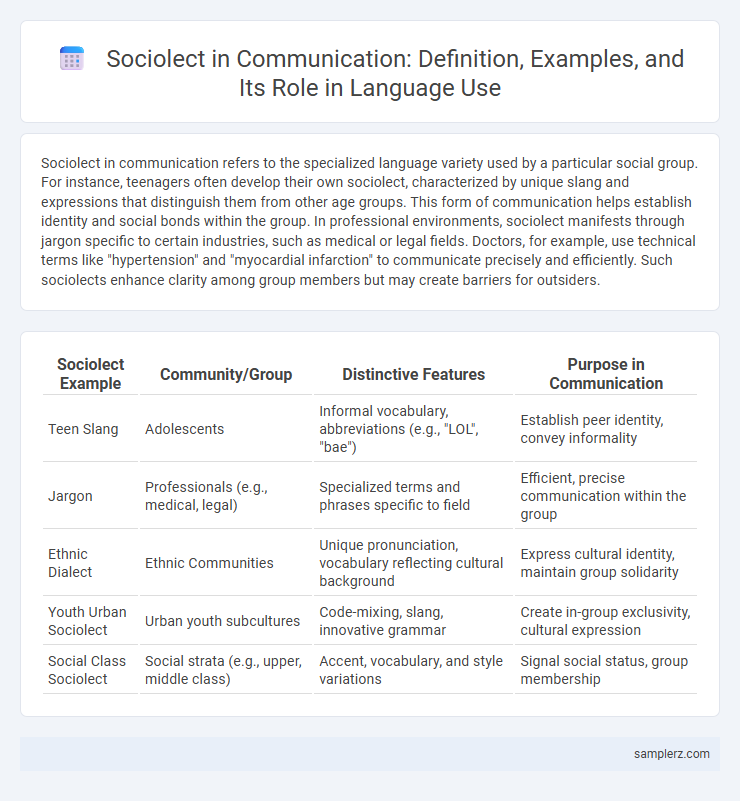Sociolect in communication refers to the specialized language variety used by a particular social group. For instance, teenagers often develop their own sociolect, characterized by unique slang and expressions that distinguish them from other age groups. This form of communication helps establish identity and social bonds within the group. In professional environments, sociolect manifests through jargon specific to certain industries, such as medical or legal fields. Doctors, for example, use technical terms like "hypertension" and "myocardial infarction" to communicate precisely and efficiently. Such sociolects enhance clarity among group members but may create barriers for outsiders.
Table of Comparison
| Sociolect Example | Community/Group | Distinctive Features | Purpose in Communication |
|---|---|---|---|
| Teen Slang | Adolescents | Informal vocabulary, abbreviations (e.g., "LOL", "bae") | Establish peer identity, convey informality |
| Jargon | Professionals (e.g., medical, legal) | Specialized terms and phrases specific to field | Efficient, precise communication within the group |
| Ethnic Dialect | Ethnic Communities | Unique pronunciation, vocabulary reflecting cultural background | Express cultural identity, maintain group solidarity |
| Youth Urban Sociolect | Urban youth subcultures | Code-mixing, slang, innovative grammar | Create in-group exclusivity, cultural expression |
| Social Class Sociolect | Social strata (e.g., upper, middle class) | Accent, vocabulary, and style variations | Signal social status, group membership |
Defining Sociolect in Modern Communication
Sociolect in modern communication refers to the distinctive language use shared by specific social groups, characterized by unique vocabulary, grammar, and pronunciation that reflect their identity and cultural background. For example, teenagers often use slang and digital abbreviations like "lit" or "BRB" to create in-group connection and differentiate themselves from other social groups. Understanding these variations enhances effective communication by acknowledging diverse social identities within digital and face-to-face interactions.
Sociolect and Its Role in Social Identity
Sociolects shape communication by reflecting the unique language patterns of specific social groups, such as teenagers using slang that distinguishes their identity within peer culture. These linguistic variations reinforce social bonds and signal membership, influencing how individuals interact and are perceived in societal contexts. Recognizing sociolects enhances understanding of social identity construction and the dynamics of group affiliation in communication.
Common Sociolects in Urban Communities
Urban communities commonly exhibit sociolects such as African American Vernacular English (AAVE), Latino English, and Cockney, which reflect distinct cultural identities and social experiences. These sociolects influence communication patterns by incorporating unique vocabulary, pronunciation, and syntax that foster group solidarity and social belonging. Understanding these sociolects enhances effective communication and promotes cultural awareness in diverse urban settings.
Workplace Sociolects: Language Among Professionals
Workplace sociolects are specialized language varieties used by professionals within specific industries or organizations, incorporating jargon, acronyms, and technical terms unique to their fields. Examples include the legal profession's use of Latin phrases like "habeas corpus" and medical staff's shorthand such as "BP" for blood pressure. These sociolects enhance precision and efficiency in communication while reinforcing group identity among colleagues.
Youth Sociolects: Defining Generational Speech
Youth sociolects, such as Generation Z's use of slang terms like "lit," "ghosting," and "flex," illustrate distinctive generational speech patterns that facilitate in-group identity and social bonding. These linguistic variations reflect cultural trends, technological influences, and shared experiences specific to younger demographics. Understanding youth sociolects is essential for effective communication across generations and helps in decoding contemporary social interactions.
Sociolect Variations in Digital Communication
Sociolect variations in digital communication manifest through specific language patterns used by distinct social groups, such as youth slang on social media platforms or professional jargon in online workspaces. These variations include unique abbreviations, emojis, and syntax that reflect group identity and cultural context. Understanding these sociolects enhances effective communication and social bonding within virtual communities.
Regional Influences on Sociolect Usage
Sociolects often reflect regional influences, where local dialects and accents shape vocabulary and pronunciation unique to a community. For example, the Cockney sociolect in East London features rhyming slang and distinct phonetic traits that influence social interactions. Understanding these regional sociolects enhances effective communication by acknowledging cultural identity and social group membership.
Sociolect and Group Belonging: Case Studies
Sociolects serve as linguistic markers that reinforce group belonging within communities, as evidenced by case studies involving youth subcultures and professional networks. For instance, the distinct jargon used by medical professionals or tech enthusiasts creates in-group cohesion and facilitates specialized communication. These sociolects not only enhance group identity but also influence social dynamics and access to information within and outside the groups.
Sociolect Barriers and Misunderstandings
Sociolect barriers in communication arise when individuals use language varieties specific to certain social groups, causing misunderstandings among speakers from different backgrounds. For example, regional slang or professional jargon can create confusion, as the intended meaning may be unfamiliar or misinterpreted by outsiders. These barriers highlight the importance of cultural competence and adaptive communication strategies to ensure clarity and effective interaction across diverse social groups.
Evolving Sociolects: Trends in Everyday Communication
Evolving sociolects in everyday communication reflect dynamic social identities shaped by technological advances and cultural shifts, such as the rise of digital slang among younger generations on social media platforms like TikTok and Instagram. These sociolects incorporate niche vocabulary and syntax, enabling distinct group identification and fostering community bonding within digital and urban environments. Continuous adaptation of sociolects demonstrates language's fluidity in response to societal changes, influencing communication patterns across various demographics.

example of sociolect in communication Infographic
 samplerz.com
samplerz.com